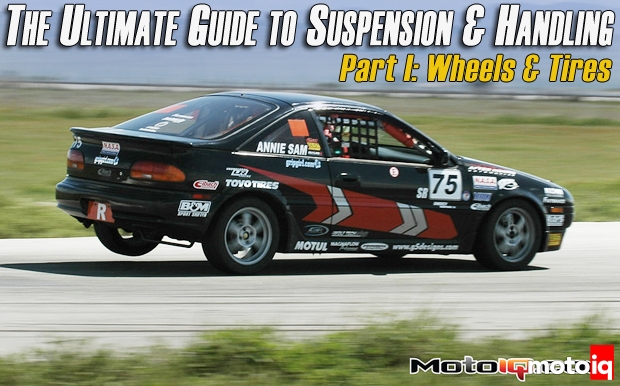The Ultimate Guide to Suspension and Handling Part I: Wheels and Tires
Horsepower is sexy and chicks dig it, at least a lot of meatheads think that way. Making horsepower is relatively easy. A lot of competent people know how to make power, lots of it. Until drifting became the rage in this country, handling and cornering prowess was for geeks, the road racing elite and autocrossers. Handling was for dweebs that raced around cones in parking lots, or loners prowling canyon roads at night, not for cool people in the scene.
How to tune a car's suspension was an unknown art in the world of mainstream performance, simply because most people didn’t care about handling. Most people emulated the world of road racing by making their cars low. Low was cool, low was handling.

Now that drifting, Time Attack, racetrack hotlapping and autocross are becoming popular, suspension tuning and handling are becoming important items for discussion, experimentation and debate. Building handling into a car is not necessarily any more complicated than building power; it’s just that the subject is somewhat more esoteric and definitive information is not as widely available.

Finding straight-line horsepower gurus for hire to help you is relatively easy, but finding an expert to make your car corner well is a tough deal, fraught with mystery and intrigue. The solution? Make yourself the guru. If your automotive interests are greater than the one-dimensional urge to blast straight down the 1320, brag about dyno sheets on internet forums or install neon and strobe lights to your interior and undercarriage, let’s get to work. There are 4 basic steps to achieving a well handling car and in this first part of our extensive series we'll discuss the first–wheels and tires.





12 comments
Hi.. This is a very informative article. Thanks for writing it. I am a student trying to learn about vehicle dynamics. I have a doubt in this article… When the example of the monster truck is given regarding the weight of the unsprung mass, the statement “For the suspension to work well, the ratio of sprung to unsprung weight must be kept as low as possible” seems contradictory. Is this a mistake or have I misunderstood it?
If the tire’s weight is high, the suspension doesn’t work well.
Ok.. Thanks
Thank you so much Mike,
For sharing those precious informations. I’m a racer and I’m actually setting up a Nissan Sentra B13 that’s powered by an SR20VE with N1 cams coupled to an SR16VE transmission. I’m debating on using 17″ wheels with 225/50/17 or 15″wheels with 205/50/15.
The track is 2.3km long with lots of in field sections and only 2 straight lines basically, one of 250 meters and the other one is 400 meters.
I’m racing against a bunch of Honda civics with B20 engines.
Now, with the 17″ setup, the car will sit higher to the ground compared to the 15″, but the tires are wider. The shorter gearing ratio with the 15″ should be a plus for acceleration, but the extra grip of the 17″ from my understanding should be better for braking and turning. The 15″ are lighter so less unsprung weight.
Sorry for the long and detailed post but I really need your input.
Thank you.
Since there are no optional gear ratios for the Nissan transmission, it’s 15″ wheels unless you are running slicks and need more brake. Your track might not be too hard on brakes.
Thanks Mike,
we are using street tires for the class I’m racing. So you don’t think that the extra grip provided by the wider 225/50/17 tires would make a big difference when braking and turning on that track compared to the 205/50/15?
Why don’t you run wider 15″s?
The class doesn’t allow wider 15″s.
Well that sucks.
Hi Mike, I am a student, I am curious to know if there is an ideal sprung to unsprung mass ratio that works well.
You want the unsprung weight to be as low as posible.
Hola. Cuál es la mejor opción para un Susuki Swift Sport que trae de fabrica unas 195/45/17: cambiarlas a 215/45/17 o 215/40/17